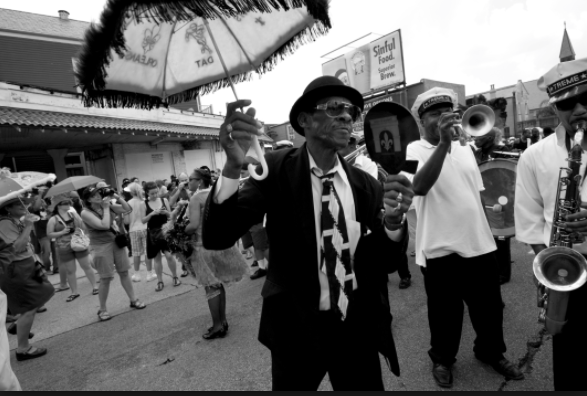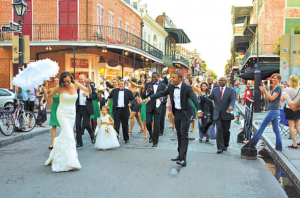Include a Topper!
-
Happy Birthday Banner
$9.00 -
Gingerbread Cake Topper
$15.00
Add Ons
Your cart is currently empty!
Since 1949 celebrating 75 years. Order online or call us at 1 800 GAMBINO (426-2466)

Whether a visitor or a local, it’s all but impossible to spend time in New Orleans without encountering a second line. Their bright, brassy set lists bring shop owners out of their stores and inspire the truest of happiness in the hearts of those they pass. There is no doubt that the second line is one of New Orleans most beloved traditions, but as with much else, we are drawn to wonder: where did they start?

Second Line Basics
For those of you who are new to the idea of a second line, at its base it is a brass band parade. The brass band usually is made up of a trumpet, a trombone, a saxophone, a tuba, a bass drum, and a snare drum, but these instruments vary depending on the band and the event. At the core of the parade is what’s called the “main line,” this includes the band itself, the krewe or club with which the band is affiliated, and in the case of funerals or weddings it includes the funeral and wedding party.
The “second line” refers to the spectators who join or follow the main line and contribute to the walking parade. This is what separates a second line from any other New Orleans parade: groups are not only welcome but encouraged to follow along, allowing the second line to grow as it marches. The term “second line” doesn’t only refer to the parade itself, it also speaks to the type of dancing you will find during those parades. “Second lining” is a highly recognizable strutting, chicken-like dance move that many people use to keep pace with the band. So “second line” is a term with many meanings; it applies to a type of parade, a part of the parade, and a dance move used within that parade.
Jazz Funeral Connections
Second lines have a multifaceted history that blends traditions of both European and African cultures and while the second line can be said to have developed in conjunction with a number of events, the one we most closely relate it to is the jazz funeral. A jazz funeral is a New Orleans tradition that has a brass band following the hearse and leading the funeral procession to the cemetery. On the march to intern the body, the brass band usually plays solemn dirges, a more classic way of experiencing a funeral. What makes the jazz funeral different from other funerals, however, is that after buying the body, the brass band transitions to upbeat, happy, and celebratory music. They lead the funeral procession away from the cemetery with a brightness that is meant to allow them to reflect on the dead’s life with joy and help them to celebrate being alive.
Second lines are still used for funerals in New Orleans, but they have evolved with a number of differences from the classic jazz funeral. Second lines tend to use upbeat songs for the entirety of their march, leaving out the dirges. Where jazz funerals are usually restricted to the family and friends of the deceased, a second line allows for others to join in, helping to celebrate and honor the life of the one who passed.
Where Do They Come From, Where Do They Go?
Most research shows the second line dating back to the mid to late 19th century, its development deeply ingrained in the African-American community in New Orleans. In large part the second line’s creation and evolution can be attributed to what we now refer to as Social Aid and Pleasure Clubs. In the period following the Civil War, African-American citizens struggled to attain proper governmental support and insurance, which incited the development of communal societies or co-ops that would provide social aid for their members. These neighborhood organizations would charge their members dues which would contribute to a fund used for basic health and funeral insurance.
One of the earliest social aid organizations was the New Orleans Freedman’s Aid Association which was founded in 1865. This specific social aid group worked to provide loans, education, and insurance to recently freed slaves in the post-Civil War era. This club, and many like it, often hosted parades and block parties to advertise their services as well as celebrate and honor members when they died. These celebrations coincided with jazz funerals and together evolved into what we now recognize as second lines.
As racial segregation began to fade in the south, the need for individualized organizations to provide insurance faded as well. This is what created the transition from social aid clubs, to pleasure clubs or benevolent societies. Contemporary Social Aid and Pleasure Clubs in New Orleans, like Zulu or the Jolly Bunch, usually don’t provide insurance anymore. Instead they are used as clubs to allow locals to engage with one another and socialize in celebratory ways. Their name, however, still references the purpose they originally served.
The Contemporary Second Line
It is New Orleans tradition to use second lines to celebrate weddings as well as funerals, but nowadays we second line for more than just these purposes. Many Social Aid and Pleasure Clubs use second lines as a way of introducing themselves to the community or providing a reason for their members to get together. It’s rare that a Sunday afternoon goes by in the French Quarter without being able to catch at least one or two second lines put on by these clubs.
You can recognize the krewe members because they are often towards the front of the parade and dressed in matching, brightly colored suits, carrying parasols, handkerchiefs, or cocktails napkins and thrusting them towards the sky. It’s also likely you will be able to see some Mardi Gras Indians during these parades.
The typical second line tends to run through neighborhoods rather than along main streets and can march anywhere from 8-20 blocks, depending on the celebration. So next time you see one passing by, contribute to this incredible New Orleans tradition and hop in line.